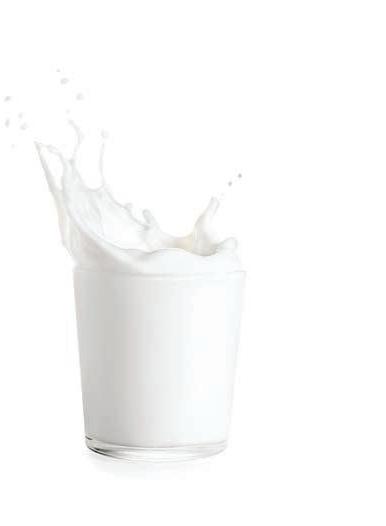ASK THE NATUROPATHIC DOCTOR
*
answers to your health questions
Should You Ditch Dairy? It’s a great source of calcium and other key nutrients, but some experts recommend avoiding it altogether. Here’s the plain truth about dairy BY EMILY A. KANE, ND, LAC
The main problem with milk in the U.S. is that it mostly comes from cows raised inhumanely and fed an extremely highglycemic diet—GMO corn mash and stale pastries from nearby supermarkets. This makes the lactose content of American milk shockingly high. And food products made from such milk, including cheese and ice cream, aren’t any better.
Managing Milk Humans have been consuming milk for centuries without the chronic irrita-
tion frequently caused by standard American milk products. So what can you do to enjoy dairy products safely? Here are a few suggestions: Know where your milk comes from.
Choose milk products that came from happy cows that lived in a pasture full-time. Go with local, small farms where the cows don’t stand all day with machines hooked up to their udders. Always buy organic, and even better, look for dairy products from grassfed cows. Try goat or sheep dairy products. Both are easier to digest (they have smaller fat globules and more medium fatty acid chains than cow’s milk). They are also higher in nutrients: Goat’s milk has more zinc and selenium than cow’s milk, and sheep’s milk boasts more vitamin B12, vitamin C, folate, and magnesium than cow or goat’s milk.
How to Ferment Your Milk First, capture the good bugs. They live everywhere, abundantly, from the air to the soil. A Japanese/Korean method starts with plain white rice plus an equal amount of water. Stir thoroughly with your hands until the liquid looks milky. Strain off liquid and leave it out, uncovered, for 36 hours in a warmer climate or 5 days in a cooler climate where the outside temperature is under 60°F. (You can cook the rice now or later as desired.) A small amount of this liquid can be scooped out with a clean ladle to rinse your face and help restore the acid mantle. Next, fill a large Mason jar about two-thirds full with 10 parts good-quality milk and 1 part of the starter liquid described above. Cover with a breathable lid such as cloth or paper towel. Fairly quickly, the curds and the whey in
20
Ferment your milk. This can be tricky (see box below), but it’s totally worthwhile because it makes the milk (or milk products) more digestible. Fermentation increases the vigor of our microbiota, the helpful microorganisms that enhance digestion and nutrient assimilation. These bugs produce enzymes and a host of other crucial compounds for human well-being, including neurotransmitters and hormones. Learn about high- and low-lactose foods. Cow’s milk contains the most
of this hard-to-digest natural sugar (skim has more than whole milk). Hard cheeses, such as cheddar, Parmesan, and Swiss, are much lower in lactose and easier to tolerate. Half-n-half, butter, and heavy cream contain even less lactose than cheese and milk, with butter and cream landing at the bottom of the list.
+
MORE DIY FERMENTED RECIPES Visit betternutrition.com for our new collection of fermented recipes that include MoroccanSpiced Carrots, Ginger-Pear Chutney, and Herbed Vegan Brie.
the milk will separate. This may take up to a week in cooler climates. Keep your ferment somewhere warmish with a stable temperature. You will see a curd form at the top that becomes quite solid. At this point, you could add spices and tinker with the curd, but what you’re really after is the whey. A small amount (¼ cup) of this liquid daily will restore health better than any probiotic. It’s also delicious. The whey will keep a few weeks in the fridge. Seal the jar with an airtight lid. To learn more about Korean Natural Farming and get recipes, start at pureknf.com.
Photo: adobestock.com
Q
I definitely feel better not eating processed wheat. What about milk products? Are they all bad for me too?
• APRIL 2020
BN0420_D_AskTheND_JS.indd 20
2/25/20 9:13 AM





